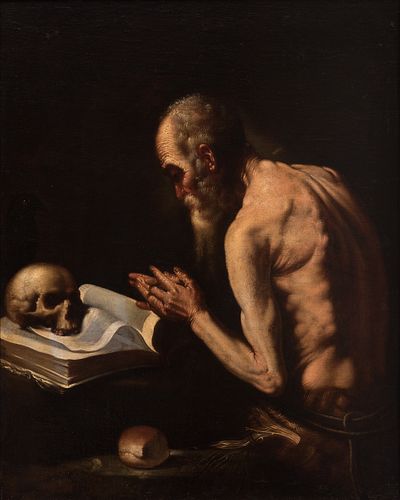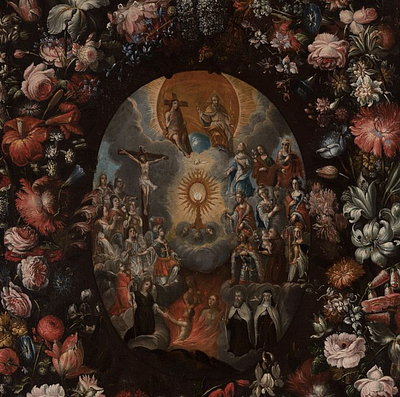Follower of JOSÉ DE RIBERA (Xátiva, Valencia, 1591 - Naples, 1652); Spanish school, mid-17th century. "Penitent Saint Jerome". Oil on canvas. Re-retou
Lot 117
About Seller
Setdart Auction House
Carrer Aragó 346
Barcelona
Spain
Setdart Subastas was born in 2004 and is currently the first online art auction in Spain with solidity, prestige and reliability guaranteed by our more than 60,000 users. Setdart has a young, dynamic and enterprising team ready to successfully manage the purchase and sale of art works through custom...Read more
Estimate:
EUR€7,000 - EUR€9,000
$7,526.88 - $9,677.42
Absentee vs Live bid
Two ways to bid:
- Leave a max absentee bid and the platform will bid on your behalf up to your maximum bid during the live auction.
- Bid live during the auction and your bids will be submitted real-time to the auctioneer.
Bid Increments
| Price | Bid Increment |
|---|---|
| EUR€0 | EUR€10 |
| EUR€200 | EUR€25 |
| EUR€500 | EUR€50 |
| EUR€1,000 | EUR€100 |
| EUR€3,000 | EUR€200 |
| EUR€5,000 | EUR€500 |
| EUR€10,000 | EUR€1,000 |
| EUR€20,000 | EUR€2,000 |
| EUR€50,000 | EUR€5,000 |
About Auction
By Setdart Auction House
Jul 14, 2021
Set Reminder
2021-07-14 06:30:00
2021-07-14 06:30:00
America/New_York
Bidsquare
Bidsquare : OLD MASTERS
https://www.bidsquare.com/auctions/setdart-auction-house/old-masters-7202
Setdart Auction House sofia@setdart.com
Setdart Auction House sofia@setdart.com
- Lot Description
Follower of JOSÉ DE RIBERA (Xátiva, Valencia, 1591 - Naples, 1652); Spanish school, mid-17th century. "Penitent Saint Jerome". Oil on canvas. Re-retouched. It presents repainting, restorations, and period frame. Measurements: 117 x 95 cm; 141 x 118 cm (frame). St. Jerome, with his back to the spectator, folds his hands in a praying attitude, in front of the bible that he has just translated, and on which a skull rests. The artist presents us with an intimate image of the saint, a moment of recollection and personal devotion, for which he has opted for aesthetic sobriety, which is reflected in a reduced chromatic range, thus avoiding the saint's characteristic red cloak, and in the concentration of few iconographic elements. It is worth mentioning that this piece is very similar to some of the works by José de Ribera. An example of this is the piece produced by the artist around 1630, which belongs to the Ingres Museum collection, in which the similarities in the way of capturing the flesh tones can be seen. Although it is true that both the composition and the conception of the work are different. Saint Jerome is one of the four great Doctors of the Latin Church. He was born near Aquileia (Italy) in 347 and trained in Rome, where he was an accomplished rhetorician and polyglot. Baptised at the age of nineteen, between 375 and 378 he withdrew to the Syrian desert to lead an anchorite's life. He returned to Rome in 382 and became a collaborator of Pope Damasus. In the second half of the 16th century a new iconography emerged in which the saint listens to the trumpet of the Apocalypse, an iconography widely used by the Counter-Reformation Church. From its subject matter and style we can situate this painting within the Neapolitan school of the 17th century around the figure of José de Ribera, a key painter belonging to the generation of the great masters of the Golden Age, trained in Italy as a self-taught artist. He first came into contact with naturalism when he arrived in Rome in 1615, where he came into contact with the Nordic Caravaggists, from whom he adopted the smooth, hurried technique, ugliness and rigorous drawing that shaped his style during his Roman period. However, in 1616 he moved to Naples and settled there permanently. In Naples Ribera became the leader of the group of Neapolitan naturalists and an important circle of painters grew up around him. Despite his stay in Italy, Ribera sent numerous works to Spain, and his language would play a key role in the development of the Baroque in our country. His work would bring tenebrism and, later, the full Baroque, long before the latter arrived directly in Spain, thus influencing the new generations of painters. On the other hand, once his Roman period was over, his painting was characterised by a very loose, Venetian-influenced brushstroke, which also marked the work of his followers. Thus, Ribera's school developed a style of dramatic, contrasting, clearly tenebrist lighting, which is nevertheless tinged by a Venetian brushstroke that is impastoed and fluid. Thus, here we see an artificial, directed spotlight that penetrates the scene from the upper right corner and directly illuminates the saint's face and hands, leaving the rest in semi-darkness. And we also find that totally modern brushstroke that models the saint by means of the light, that touch of pasty, expressive brushstroke that the artist learned directly from Ribera's work.
- Shipping Info
-
In-house shipping available. Please inquire at admin@setdart.com.
-
- Buyer's Premium



 EUR
EUR CAD
CAD AUD
AUD GBP
GBP MXN
MXN HKD
HKD CNY
CNY MYR
MYR SEK
SEK SGD
SGD CHF
CHF THB
THB

















